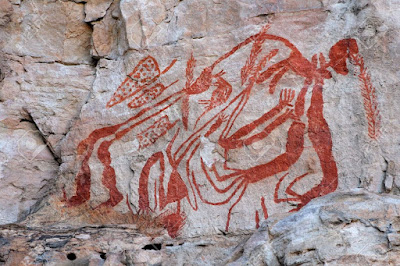In amongst the wetlands, wildlife and rugged
gorges, World Heritage-listed Kakadu National Park holds one of the
highest concentrated areas of rock art in the world. As many as 5,000
Aboriginal sites have been found here, including rock art, shelters,
stone tools, grindstones and ceremonial ochre. This detailed, dramatic
record of life in Kakadu stretches back more than 50,000 years - from
the first evidence of human occupation to the arrival of Europeans.
Aboriginal families camped in rock shelters around Ubirr in Kakadu's north-east, and today you can see paintings of the fish and animals they hunted. Barramundi, catfish, mullet, goannas, turtles, possums and wallabies line the back wall in the main gallery in a rich, ochre tapestry of life. You'll also see some of the world's finest examples of X-ray art - where animals' bones and organs are as visible as their exteriors - in this gallery. Other paintings record contact with the first ‘whitefellas' in the area, thought to be the early buffalo hunters of the 1880s. One has his hands in his pockets, while another has his hands on his hips and is ‘bossing Aboriginal people around'.
Aboriginal families camped in rock shelters around Ubirr in Kakadu's north-east, and today you can see paintings of the fish and animals they hunted. Barramundi, catfish, mullet, goannas, turtles, possums and wallabies line the back wall in the main gallery in a rich, ochre tapestry of life. You'll also see some of the world's finest examples of X-ray art - where animals' bones and organs are as visible as their exteriors - in this gallery. Other paintings record contact with the first ‘whitefellas' in the area, thought to be the early buffalo hunters of the 1880s. One has his hands in his pockets, while another has his hands on his hips and is ‘bossing Aboriginal people around'.
Not far from this gallery you'll find
paintings of the Namarrgarn Sisters - cunning spirits who live in the
stars and can make people sick with a string. In another site in the
area you'll see a painting of the Rainbow Serpent that is more than
23,000 years old. This quietly powerful 'boss lady' is known as
Garranga'rrelito to the local Gagudju tribe.
At Nourlangie Rock, an outlying formation of the Arnhem Land Escarpment, you can see the crevices cut by Dreamtime ancestors in the form of short-eared rock wallabies. These crevices are still visible today, and rock wallabies are often seen there in the early morning and dusk. In the nearby Anbangang Gallery you'll see a painting of Lightning Man, the Dreamtime ancestor who still controls the violent lightning storms that happen every wet season. Nearby is Nanguluwu, where acclaimed artist Najombolmi painted a Mimi Dreamtime spirit figure throwing a spear during the 1960s. You'll also see paintings depicting the arrival of Europeans - including one of a two-masted sailing ship with anchor chain and dinghy trailing behind.
At Nourlangie Rock, an outlying formation of the Arnhem Land Escarpment, you can see the crevices cut by Dreamtime ancestors in the form of short-eared rock wallabies. These crevices are still visible today, and rock wallabies are often seen there in the early morning and dusk. In the nearby Anbangang Gallery you'll see a painting of Lightning Man, the Dreamtime ancestor who still controls the violent lightning storms that happen every wet season. Nearby is Nanguluwu, where acclaimed artist Najombolmi painted a Mimi Dreamtime spirit figure throwing a spear during the 1960s. You'll also see paintings depicting the arrival of Europeans - including one of a two-masted sailing ship with anchor chain and dinghy trailing behind.
According to Dreamtime myth, Mimi spirits
were the first ancestors to paint on rock. They passed their knowledge
on to some Aboriginal people, while others learned by copying Mimi art.
Sometimes ancestral spirits entered rock walls as paintings, turning
them into sacred dreaming places.
With the arrival of Europeans and the changing lifestyle of Aboriginal people, the tradition of rock art has been largely succeeded by painting on bark, paper and canvas. Kakadu's most recent rock art was painted in 1986 and the last flurry of activity before that was Najombolmi's work during the 1960s.
Today you can explore this vast cultural treasure trove with a local Aboriginal guide. In amongst Kakadu's lush rainforest lies an epic history of human occupation.
With the arrival of Europeans and the changing lifestyle of Aboriginal people, the tradition of rock art has been largely succeeded by painting on bark, paper and canvas. Kakadu's most recent rock art was painted in 1986 and the last flurry of activity before that was Najombolmi's work during the 1960s.
Today you can explore this vast cultural treasure trove with a local Aboriginal guide. In amongst Kakadu's lush rainforest lies an epic history of human occupation.






















0 comments:
Post a Comment